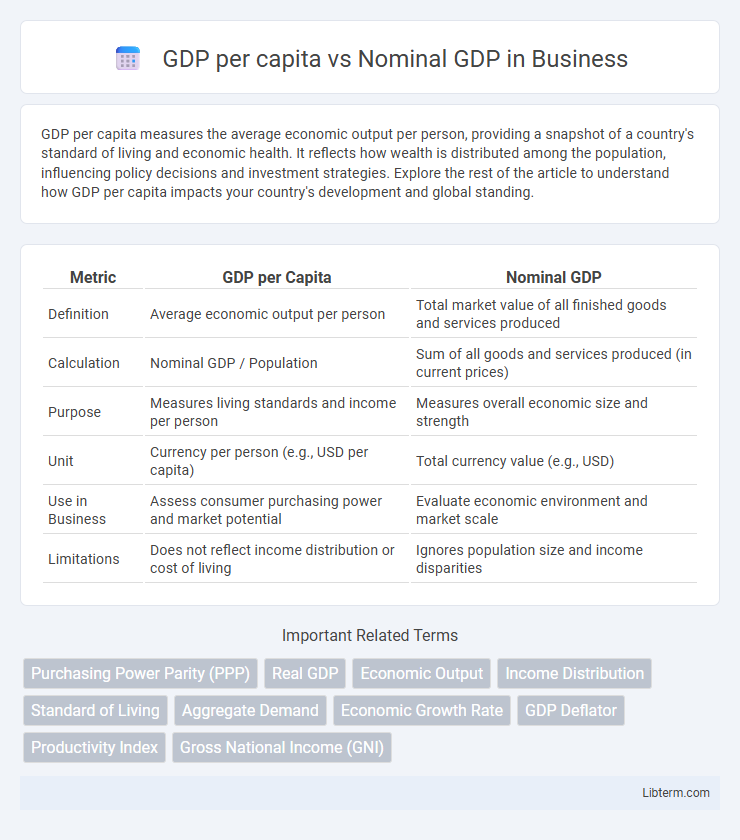GDP per capita measures the average economic output per person, providing a snapshot of a country's standard of living and economic health. It reflects how wealth is distributed among the population, influencing policy decisions and investment strategies. Explore the rest of the article to understand how GDP per capita impacts your country's development and global standing.
Table of Comparison
| Metric | GDP per Capita | Nominal GDP |
|---|---|---|
| Definition | Average economic output per person | Total market value of all finished goods and services produced |
| Calculation | Nominal GDP / Population | Sum of all goods and services produced (in current prices) |
| Purpose | Measures living standards and income per person | Measures overall economic size and strength |
| Unit | Currency per person (e.g., USD per capita) | Total currency value (e.g., USD) |
| Use in Business | Assess consumer purchasing power and market potential | Evaluate economic environment and market scale |
| Limitations | Does not reflect income distribution or cost of living | Ignores population size and income disparities |
Understanding GDP: Definition and Importance
GDP per capita measures the average economic output per person, providing insight into the standard of living and economic well-being within a country. Nominal GDP represents the total market value of all goods and services produced in a country without adjusting for population size or inflation. Understanding both metrics is crucial for comparing economic performance, where nominal GDP highlights overall economic size and GDP per capita reflects individual prosperity.
What is Nominal GDP?
Nominal GDP measures the total market value of all final goods and services produced within a country during a specific period, calculated using current prices without adjusting for inflation. It reflects the economy's size and economic activity but does not account for population differences, making it distinct from GDP per capita. GDP per capita divides Nominal GDP by the population, providing a per-person economic output measure that better indicates living standards.
Exploring GDP Per Capita
GDP per capita measures the average economic output per person, providing a clearer picture of individual wealth and living standards than Nominal GDP, which reflects the total economic output without adjusting for population size. By dividing Nominal GDP by the total population, GDP per capita allows for accurate comparisons between countries with varying population scales. This metric is crucial for assessing economic well-being and guiding policy decisions aimed at improving citizens' quality of life.
Key Differences Between Nominal GDP and GDP Per Capita
Nominal GDP measures the total market value of all goods and services produced within a country over a specific period, reflecting the overall economic size without adjusting for population. GDP per capita divides this total nominal GDP by the population, providing an average economic output per person that better indicates individual prosperity and living standards. While Nominal GDP emphasizes the scale of the economy, GDP per capita focuses on wealth distribution and economic well-being across the population.
How to Calculate Nominal GDP
Nominal GDP represents the total market value of all final goods and services produced in a country within a specific period, calculated by summing the current prices of all goods and services. To calculate Nominal GDP, multiply the quantity of each good or service produced by its current market price, then aggregate these values across all sectors of the economy. This contrasts with GDP per capita, which divides Nominal GDP by the total population to measure average economic output per person.
Calculating GDP Per Capita: Step-by-Step
Calculating GDP per capita involves dividing a country's Nominal GDP by its total population, providing an average economic output per person. First, ensure the Nominal GDP is measured in consistent currency units, typically USD for global comparisons. Next, obtain the most recent and accurate population data, then perform the division for an insightful measure of individual economic prosperity.
Economic Insights from Nominal GDP
Nominal GDP provides a comprehensive snapshot of a country's total economic output at current market prices, essential for evaluating overall economic size and growth trends. This metric, unlike GDP per capita, captures the aggregate market value of all goods and services produced without adjusting for population size, offering vital insights into national economic strength and global economic ranking. Policymakers and investors rely on nominal GDP to assess market potential, fiscal health, and to formulate economic strategies.
Why GDP Per Capita Matters in Economic Comparisons
GDP per capita offers a clearer measure of individual economic well-being by dividing the nominal GDP by the population, revealing average income levels within a country. Unlike nominal GDP, which only shows total economic output, GDP per capita adjusts for population size, making it essential for comparing living standards across nations. This metric helps policymakers and analysts assess economic prosperity and identify disparities that nominal GDP alone cannot capture.
Limitations and Misconceptions of GDP Metrics
GDP per capita often misrepresents individual wealth by averaging income, overlooking income inequality and regional disparities within a country. Nominal GDP can be misleading when comparing economic size across countries due to currency fluctuations and differences in cost of living. Both metrics fail to account for informal economies, environmental degradation, and quality of life, limiting their effectiveness as comprehensive measures of economic well-being.
Which GDP Metric to Use: Contexts and Applications
GDP per capita provides a more accurate measure of individual economic well-being by dividing nominal GDP by the population, making it ideal for comparing living standards across countries or regions. Nominal GDP quantifies the total economic output without adjustments, useful for assessing market size and overall economic performance in current prices. Choosing between these metrics depends on the context: use GDP per capita for living standards and nominal GDP for market potential and aggregate wealth evaluations.
GDP per capita Infographic

 libterm.com
libterm.com